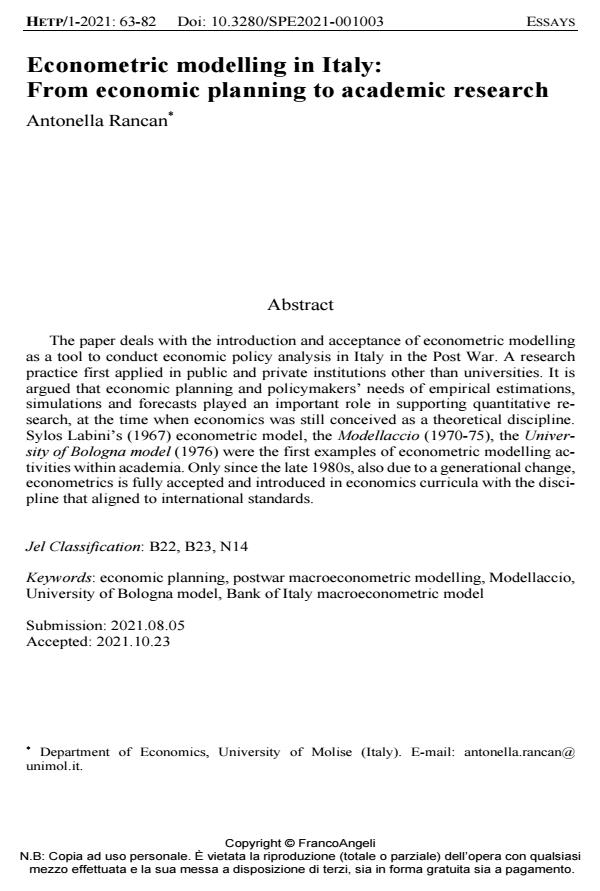Econometric modelling in Italy: From economic planning to academic research
Journal title HISTORY OF ECONOMIC THOUGHT AND POLICY
Author/s Antonella Rancan
Publishing Year 2021 Issue 2021/1
Language English Pages 20 P. 63-82 File size 271 KB
DOI 10.3280/SPE2021-001003
DOI is like a bar code for intellectual property: to have more infomation
click here
Below, you can see the article first page
If you want to buy this article in PDF format, you can do it, following the instructions to buy download credits

FrancoAngeli is member of Publishers International Linking Association, Inc (PILA), a not-for-profit association which run the CrossRef service enabling links to and from online scholarly content.
The paper deals with the introduction and acceptance of econometric model-ling as a tool to conduct economic policy analysis in Italy in the Post War. A re-search practice first applied in public and private institutions other than universi-ties. It is argued that economic planning and policymakers’ needs of empirical es-timations, simulations and forecasts played an important role in supporting quan-titative research, at the time when economics was still conceived as a theoretical discipline. Sylos Labini’s (1967) econometric model, the Modellaccio (1970-75), the University of Bologna model (1976) were the first examples of econometric modelling activities within academia. Only since the late 1980s, also due to a gen-erational change, econometrics is fully accepted and introduced in economics cur-ricula with the discipline that aligned to international standards.
Keywords: economic planning, postwar macroeconometric modelling, Modellac-cio, University of Bologna model, Bank of Italy macroeconometric model
Jel codes: B22, B23, N14
- Hidden female figures in the organisation for European economic co-operation, and the reconstruction of Europe after WWII Rebeca Gomez Betancourt, Giulia Zacchia, in The European Journal of the History of Economic Thought /2023 pp.1170
DOI: 10.1080/09672567.2023.2239969 - Redefining scientization: Central banks between science and politics Aurélien Goutsmedt, Francesco Sergi, in Finance and Society /2025 pp.209
DOI: 10.1017/fas.2025.7 - Ragnar Frisch, the 1961 Feltrinelli Prize and Its Paretian Context Rogério Arthmar, Michael McLure, in History of Economics Review /2025 pp.1
DOI: 10.1080/10370196.2025.2544399 - Modelling Europe Antonella Rancan, Francesco Sergi, pp.19 (ISBN:978-3-031-63090-3)
Antonella Rancan, Econometric modelling in Italy: From economic planning to academic research in "HISTORY OF ECONOMIC THOUGHT AND POLICY" 1/2021, pp 63-82, DOI: 10.3280/SPE2021-001003